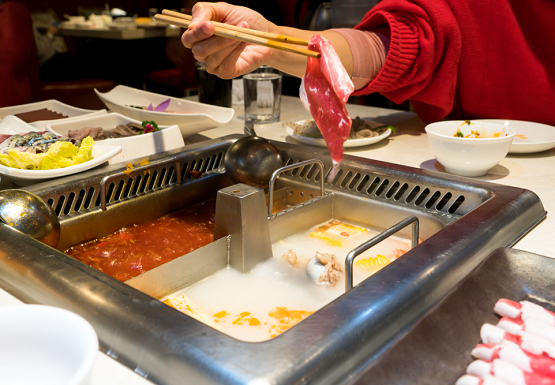
Whether you make your own hotpot at home or have it at a restaurant, there is a vast array of soup broths and ingredients to choose from. Which should you go for if you want to enjoy hotpot in a healthy way?
Hotpot, also known as steamboat, is a popular hearty meal of a simmering pot of soup – with raw meat, seafood, vegetables and other ingredients placed into the broth to cook. The meal is accompanied with dipping sauces for cooked food.
Hotpot has its origins in China – and there are many Chinese varieties. Sichuan or Chongqing hotpot was of the first and until today, remains an attractive option for hotpot enthusiasts. There are also Japanese versions (shabu-shabu), Korean types (army stew and some with barbeque grills) and many others which have sprung up over the years.
Different flavours of soup broths depend on the type of soup base and the sauces, spices and meats added. Spicy hotpots are popular – and typically have dried whole chillis, a spicy soup base and peppercorn added.
Let’s have a look at some common hotpot broths and ingredients.
Hotpot Broths
Sodium content per serving (100g)
| Tomato Soup | Spicy Hotpot | Mushroom | Seafood | Laksa | Spicy Sichuan | Chicken | Bah Ku Teh |
|---|---|---|---|---|---|---|---|
| 3840mg | 2800mg | 5723mg | 7647mg | 2155mg | 5889mg | 9890mg | 12778mg |
A typical hot pot broth exceeds 7000mg of sodium per serving, surpassing the recommended daily allowance of 2000mg per day (or 1 teaspoon of salt). So reduce your intake of the broth.
Some varieties such as spicy broths are high in fat as well, due to the large amounts of oil. If coconut milk is added (such as in laksa broths) or if broths are based on offal or fatty meat (such as pig stomach soup) – these increase the saturated fat content of your meal.
Choose a clear or light-flavoured soup instead – see more in ‘Tips to have a healthy hotpot’ below!
Hotpot Ingredients
| Meat and Seafood | • Chicken (including intestines, liver and kidney) •Beef •Pork (including pig brain, pork belly, intestines, liver and kidney) •Fish •Prawns •Squid •Cuttlefish •Scallops •Cockles •Crab •Lobster |
Other Protein | •Tofu (including cheese-filled) •Tau pok •Egg •Dumplings •Crabstick •Luncheon meat •Hot dog •Meatballs •Fish balls •Cuttlefish balls |
Vegetables | • Leafy vegetables (variety, including lettuce, cabbage and spinach) •Mushrooms •Corn •Potato •Bamboo shoots •Wintermelon •Lotus root •Yam •Radish |
Sides / Acompaniments | •Rice •Noodles •Deep fried fish skin •Deep fried beancurd skin •Fried tofu •Chicken nuggets •Chicken wings |
|---|
Your hotpot meal can vary widely in nutritional value depending on the ingredients you choose. Low-calorie items which are good choices include vegetables, tofu and lean meat such as chicken and fish. Fried sides, offal (or internal organs) and fatty cuts of meat like pork belly and shabu-shabu are much higher in calories and fat. A 50g serving of pork belly has 230 calories and 20g fat which is equivalent to a curry puff.
Meatballs, luncheon meat and hot dogs are processed and high in sodium. Even more so if they are combined with salty broth and dipping sauces! Having 10 fish balls, meatballs or cuttlefish balls cooked in broth with dipping sauces will exceed your recommended sodium intake.
Too much high-fat food can lead to weight gain and chronic conditions such as heart disease. And having salty items frequently in large amounts increases the risk of high blood pressure and kidney problems.
Tips to have a healthy hotpot!
Limit your hotpots to 1 to 2 times a month, especially if you are having spicy broths and ingredients high in fat and sodium. However, if you choose fresh ingredients and clear soups then you can have it more frequently. If you are making hotpot at home, choose fresh ingredients and low-sodium stock cubes or your own homemade broths for the soup.
REFERENCES
Cheong T. (2016) 8 Tips for a Healthy Hot Pot. Healthxchange.sg SingHealth. Singapore General Hospital. Retrieved from <https://www.healthxchange.sg/food-nutrition/food-tips/tips-healthy-hot-pot>
Accessed 22 September 2019.
Haidilao Hot Pot (n.d.) Haidilao Cuisine. Retrieved from <https://www.haidilao.com>
Accessed 22 September 2019.
Health Promotion Board – Energy and Nutrient Composition of Food
Health Promotion Board (2019). How to Eat Right to Feel Right. HealthHub. Retrieved from: <https://www.healthhub.sg/live-healthy/15/dietary_guidelines_adults>
Accessed 23 September 2019.
National Cancer Institute at the National Institutes of Health (2017) Chemicals in Meat Cooked at High Temperatures and Cancer Risk. Retrieved from:
< https://www.cancer.gov/about-cancer/causes-prevention/risk/diet/cooked-meats-fact-sheet#r1>
Accessed 22 September 2019.
Poh O. (2019) 10 Best Steamboat Restaurants In Singapore Worth Queuing For. Retrieved from:
<https://sethlui.com/best-steamboat-singapore/>
Accessed 24 September 2019.
Poh O. (2018) Beauty In The Pot 美滋锅: One Of The Best Collagen Steamboats In Singapore. Retrieved from:
<https://sethlui.com/beauty-in-the-pot-singapore-steamboat-review/>
Accessed 24 September 2019.
San Laksa Steamboat (n.d.) Food Menu. Retrieved from
<http://www.sanlaksa.com.sg/menu.html>
Accessed 24 September 2019.
Tai W.L. (2019) The Indigenization and Hybridization of Food Cultures in Singapore. Palgrave Pivot. ISBN 9789811386954. p.28
This article is contributed by our dietitians from the Nutrition and Dietitian department of Mount Alvernia Hospital. To learn more about our Nutrition and Dietitian services, click here